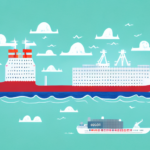Understanding the Basic Shipping Process
Shipping is a critical component of any business that deals in the sale and delivery of goods. It involves the movement of products from one location to another, typically from the manufacturer or supplier to the retailer or end consumer. In this article, we will explore the various aspects of shipping and offer expert insights on how to make the process more efficient and cost-effective.
The Importance of Shipping in Business
Shipping serves as the backbone of global trade, connecting businesses and individuals across borders and oceans. It enables businesses to access new markets and customers, increase sales revenue, and create opportunities for growth. According to the World Bank, the shipping industry accounts for over 80% of global trade by volume, highlighting its significance in maintaining supply chain integrity and ensuring timely and secure delivery of goods.
Moreover, shipping has a considerable impact on the environment. As global awareness of climate change grows, the shipping industry faces increasing pressure to reduce its carbon footprint. Many companies are investing in eco-friendly technologies and practices, such as using alternative fuels, optimizing shipping routes to minimize emissions, and adopting energy-efficient vessel designs. By prioritizing sustainability, businesses can not only reduce their environmental impact but also attract consumers who are increasingly concerned about the social and environmental implications of their purchases.
The Different Modes of Shipping
Air Freight
Air freight is the fastest mode of transport, making it ideal for shipping perishable goods or urgent shipments. However, it is generally the most expensive option, accounting for approximately 35% of global trade value despite only handling 4% of trade volume (ICAO).
Sea Freight
Sea freight is the most cost-effective mode for long-distance shipments, handling the majority of global trade by volume. While the transit time is longer compared to air freight, advancements in containerization and port operations have made sea shipping more efficient and reliable.
Road and Rail Freight
Road and rail freight are best suited for local and regional shipments, offering greater flexibility and faster transit times compared to sea freight. These modes are essential for the "last mile" delivery in supply chains, ensuring goods reach their final destinations promptly.
Intermodal Transportation
Intermodal transportation involves using multiple modes of transportation, such as combining sea and rail or road and air, to optimize the shipping process. This approach can offer cost savings and reduce the environmental impact of shipping by selecting the most efficient mode for each leg of the journey.
- Advantages of intermodal transportation include reduced handling costs, lower risk of damage, and improved sustainability.
- Challenges include coordinating schedules and ensuring seamless transfer between different transportation modes.
It's crucial to consider the specific needs of your shipment when choosing a mode of shipping. Factors such as size, weight, and the nature of the goods (e.g., hazardous materials) can influence the most suitable transportation mode.
Common Shipping Terminologies Explained
Understanding shipping terminologies is essential for navigating the complexities of the industry. Here are some of the most common terms:
- Bill of Lading: A legal document that serves as a contract between the shipper and the carrier, specifying the details of the shipment and its terms of delivery.
- Freight Forwarder: A company that specializes in arranging and managing the shipment of goods from one location to another, often acting as a liaison between the shipper and the carrier.
- Incoterms: A set of international rules that define the responsibilities of buyers and sellers in international trade, including the transfer of ownership, delivery, and risk.
- Container: A standard unit for transporting goods, often made of steel, designed to be shipped by sea, rail, or truck.
Types of Containers
- Dry Containers: The most common type used for shipping general cargo, such as electronics, clothing, and furniture.
- Refrigerated Containers: Also known as "reefers," these are used for shipping perishable goods that require temperature-controlled environments.
- Open-top Containers: Containers with an open top, allowing for easy loading and unloading of oversized cargo like machinery and vehicles.
- Flat Rack Containers: Equipped with collapsible sides, ideal for shipping oversized cargo that cannot fit in a standard container.
What Factors Affect Shipping Costs?
Shipping costs can vary significantly based on several factors:
- Distance: Longer distances generally result in higher shipping costs.
- Weight and Volume: Heavier and larger shipments incur higher costs.
- Mode of Transport: Air freight is typically more expensive than sea or land transport.
- Fuel Prices: Fluctuations in fuel prices can impact shipping rates.
- Carrier Rates: Different carriers offer varying pricing structures based on their services and coverage.
- Customs Fees and Duties: International shipments may be subject to additional taxes and fees.
- Seasonal Demand: Peak seasons can lead to higher shipping costs due to increased demand.
The type of product being shipped also plays a role. Fragile or hazardous items may require special packaging and handling, increasing overall shipping costs. Additionally, carrier restrictions on certain types of goods can limit shipping options and potentially raise costs.
How to Choose the Right Shipping Carrier
Evaluate Service Offerings
Consider the range of services offered by carriers, including delivery options, transit times, and specialized services for handling specific types of goods.
Pricing and Cost-Effectiveness
Compare rates from multiple carriers to ensure competitive pricing. Negotiating bulk rates can lead to cost savings for businesses with high shipping volumes.
Reputation and Reliability
Research carrier reputations through reviews and industry ratings. Reliable carriers with a history of on-time deliveries and secure handling of goods are preferable.
Coverage Area
Ensure the carrier provides comprehensive coverage, both domestically and internationally, to meet your shipping needs. Limited coverage areas can restrict market reach.
Technology and Tracking Capabilities
Carriers that offer advanced tracking systems provide real-time updates, enhancing transparency and allowing for better shipment management. Integration with e-commerce platforms can also streamline the shipping process.
Understanding Customs and Duties for International Shipping
International shipping involves navigating customs regulations and duties, which can significantly impact the final delivery cost of goods. Customs duties are taxes imposed by governments on imported goods, and customs clearance involves the documentation and processes required for goods to enter a foreign country.
Essential Documentation
- Invoices: Detailed listings of goods being shipped, their value, and payment terms.
- Packing Lists: Inventories of the shipped items, including quantities and descriptions.
- Export Declarations: Formal statements declaring goods being exported, required by many countries.
Compliance with Regulations
Each country has unique rules and restrictions on imports. Researching and understanding these regulations is crucial to avoid delays or seizures of shipments. Certain goods may require specific certifications or permits, such as food products needing health inspections or medical supplies requiring special licenses.
Staying informed about the latest customs regulations and working with experienced customs brokers can facilitate smoother international shipping operations.
Tips for Efficient Packaging and Labeling
Proper packaging and labeling are essential for ensuring the safety of your goods during transit and enhancing the efficiency of the shipping process.
Effective Packaging Strategies
- Use sturdy, high-quality containers that can withstand transportation stresses.
- Opt for sustainable packaging materials to reduce environmental impact.
- Ensure appropriate weight distribution to prevent damage.
Accurate Labeling
- Clearly display shipping information, including sender and recipient details.
- Use barcode labels for easy scanning and tracking.
- Include handling instructions, such as "Fragile" or "Keep Upright," to guide carriers.
Adhering to standard shipping guidelines and regulations ensures compliance and minimizes the risk of shipment delays or damages.
Tracking Your Shipment: How It Works
Modern shipping carriers offer tracking services that enable businesses and customers to monitor the progress of shipments in real-time. Tracking typically involves a unique tracking number or code assigned to each shipment, which can be used to access information about the shipment's current location, delivery status, and estimated delivery date.
- Real-Time Updates: Track the movement of your shipment at various checkpoints throughout its journey.
- Enhanced Transparency: Gain insights into potential delays and proactively manage disruptions.
- Customer Communication: Provide customers with accurate delivery estimates, improving satisfaction and trust.
Implementing efficient tracking systems not only improves operational efficiency but also enhances the overall customer experience.
Dealing with Shipping Challenges and Delays
Shipping inevitably faces challenges and delays due to factors such as weather disruptions, customs delays, carrier strikes, and system failures. To mitigate these issues, businesses can adopt several strategies:
Proactive Planning
- Ensure all necessary documentation is accurate and completed in advance.
- Maintain buffer times in shipping schedules to accommodate unexpected delays.
Diversifying Carriers and Modes
- Utilize multiple carriers to avoid reliance on a single provider.
- Adopt intermodal transportation to enhance flexibility and resilience.
Implementing Contingency Plans
- Develop backup plans for critical shipments.
- Establish strong communication channels with carriers to receive timely updates.
By anticipating potential challenges and preparing accordingly, businesses can minimize the impact of shipping delays on their operations and customer satisfaction.
Eco-Friendly Shipping: Reducing Your Carbon Footprint
Environmental sustainability is increasingly a priority for businesses, and the shipping industry is taking steps to reduce its carbon footprint. Here are some strategies to adopt eco-friendly shipping practices:
Utilize Fuel-Efficient Transportation Modes
Opt for shipping methods that consume less fuel, such as rail over road transportation for long distances.
Optimize Transportation Routes
Plan efficient routes to minimize travel distance and reduce emissions.
Reduce Packaging Waste
Use minimal and recyclable packaging materials to decrease waste generated from shipments.
Source Sustainable Materials
Choose suppliers and materials that prioritize sustainability to support environmentally responsible shipping practices.
Implementing these practices not only benefits the environment but can also lead to cost savings and enhance a company's reputation as a responsible business.
Improving Customer Experience with Effective Shipping Practices
Shipping plays a critical role in customer satisfaction and loyalty. Efficient and reliable shipping can significantly influence repeat purchases and positive reviews. Here are ways to enhance the shipping experience for customers:
Transparent Communication
- Provide regular shipping updates and notifications to keep customers informed.
- Offer clear information on shipping times, costs, and policies.
Flexible Delivery Options
- Offer various delivery speeds, including expedited shipping for customers who need their orders quickly.
- Provide multiple delivery locations, such as home, office, or pickup points, to accommodate customer preferences.
Reliable Tracking Systems
- Implement robust tracking systems that allow customers to monitor their shipments in real-time.
- Ensure tracking information is easily accessible and user-friendly.
Hassle-Free Returns Policy
Offer a straightforward and flexible returns policy to increase customer confidence in the purchasing process. Easy returns can enhance overall satisfaction and encourage repeat business.
By prioritizing effective shipping practices, businesses can create a positive customer experience that fosters loyalty and drives growth.
The Future of Shipping: Trends and Innovations
The shipping industry is rapidly evolving, driven by technological advancements and changing market demands. Emerging trends and innovations are transforming how goods are transported and managed:
Automated Shipping
Automation technologies, including autonomous vessels and robotic handling systems, are streamlining shipping operations, reducing labor costs, and increasing efficiency.
Drone Deliveries
Drone technology is enabling faster and more flexible delivery options, particularly for last-mile logistics in urban areas.
Blockchain-Enabled Tracking
Blockchain technology offers secure and transparent tracking of shipments, enhancing trust and reducing the risk of fraud or errors in documentation.
Mobile Shipping Management Apps
Mobile applications are providing businesses with greater control and visibility over their shipping processes, allowing for real-time management and decision-making.
Staying abreast of these trends and adopting relevant innovations can help businesses optimize their shipping operations, reduce costs, and improve customer satisfaction.
Choosing the Right Software for Streamlining Your Shipping Process
Shipping software is essential for managing logistics, tracking shipments, and automating shipping tasks. When selecting shipping software, consider the following features:
- Real-Time Tracking: Monitor shipments in real-time to ensure timely deliveries and proactive issue management.
- Automated Label Printing and Documentation: Streamline the creation of shipping labels, invoices, and customs documents to save time and reduce errors.
- Integration with Carrier Services: Ensure the software seamlessly integrates with various carriers to access their services and rates.
- User-Friendly Interface: Choose software that is intuitive and easy to navigate for efficient use by your team.
- Customization Options: Select software that can be tailored to meet the unique needs of your business operations.
Implementing robust shipping software can enhance operational efficiency, reduce manual workload, and provide valuable insights into your shipping processes.
Creating a Budget-Friendly Shipping Strategy for Small Businesses
Managing shipping costs is vital for the profitability of small businesses. Here are strategies to develop a budget-friendly shipping plan:
Consolidate Shipments
Grouping multiple orders into a single shipment can reduce overall shipping costs and minimize packaging materials.
Negotiate Bulk Rates with Carriers
Engage in negotiations with shipping carriers to secure lower rates based on higher shipping volumes.
Optimize Packaging
Use appropriate packaging to reduce weight and volume, thereby lowering shipping costs. Lightweight and compact packaging also reduces material costs.
Leverage Third-Party Logistics Providers (3PL)
Utilizing 3PL services can offer economies of scale and access to discounted shipping rates, helping small businesses save on logistics expenses.
By implementing these cost-saving measures, small businesses can effectively manage shipping expenses and allocate resources to other critical areas of their operations.
In conclusion, shipping is an essential component of any business involved in the sale and delivery of goods. By understanding the basic shipping process and adopting best practices, businesses can enhance shipping efficiency, reduce costs, and improve customer satisfaction.






















